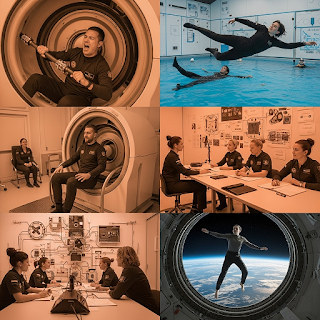Pre-Space Travel Medical Evaluation
Space tourism candidates undergo comprehensive medical evaluations that extend far beyond typical health screenings. These assessments include cardiovascular stress tests, vestibular function analysis, and psychological evaluations designed to identify potential issues in zero-gravity environments.
Blood pressure monitoring, eye examinations, and bone density scans form part of the standard protocol. Participants must demonstrate the ability to handle rapid pressure changes and maintain cognitive function under stress. Medical clearance can take 4-8 weeks to complete, with some conditions requiring ongoing monitoring.
Physical Training Requirements
The preparation phase involves specialized physical conditioning that focuses on G-force tolerance and spatial orientation. Participants spend time in centrifuge machines that simulate launch and re-entry forces, typically reaching 3-4 G's during training sessions.
Parabolic flight training introduces candidates to weightlessness in controlled intervals, allowing them to practice movement and basic tasks in microgravity. This training helps reduce motion sickness and builds confidence for the actual space experience.
Psychological Readiness Programs
Mental preparation encompasses stress management techniques, confinement tolerance exercises, and emergency response protocols. Participants learn breathing techniques and mindfulness practices to manage anxiety during critical flight phases.
Simulation exercises replicate the confined space environment, complete with the sounds, vibrations, and visual elements of actual spaceflight. These sessions help identify individuals who may experience claustrophobia or panic responses in the spacecraft cabin.
Technical Systems Education
Space tourists receive instruction on spacecraft systems, safety equipment, and emergency procedures. This includes understanding life support systems, communication protocols, and proper use of restraint systems during different flight phases.
Participants learn to operate basic controls, understand instrument readings, and respond to crew instructions during normal and emergency situations. The technical training typically requires 40-60 hours of classroom and hands-on instruction.
The Launch Experience
The actual launch sequence begins with final medical checks and suit fitting procedures. Participants experience a gradual build-up of acceleration forces as the spacecraft climbs through the atmosphere, with communication maintained through integrated headset systems.
The transition from powered flight to weightlessness occurs within minutes, creating an immediate shift in sensory experience. Participants report varying degrees of disorientation as their bodies adapt to the absence of gravitational reference points.
Weightlessness Sensation
The microgravity experience affects each individual differently, with some adapting quickly while others require several minutes to adjust. Movement becomes fluid and three-dimensional, requiring new muscle memory and spatial awareness.
Participants often describe the sensation as initially overwhelming, followed by a period of euphoria as they master basic movement in the weightless environment. The ability to float, rotate, and push off surfaces creates a unique physical experience unlike any terrestrial activity.
Visual and Sensory Elements
The view of Earth from space provides a perspective that participants describe as profoundly moving. The curvature of the planet, the thin atmosphere, and the stark contrast between Earth and space create lasting visual memories.
Window positioning and lighting conditions affect the viewing experience, with some seats offering better perspectives than others. The duration of the viewing opportunity varies by mission type, from brief glimpses during suborbital flights to extended observation periods on orbital missions.
Communication During Flight
Participants maintain contact with ground control and can communicate with family members through designated communication windows. The spacecraft's communication systems allow for real-time sharing of the experience with loved ones on Earth.
In-flight photography and video recording capture personal moments, though participants must balance documentation with experiencing the moment directly. Some operators provide professional photography services to ensure quality documentation of the experience.
Re-entry and Landing Preparation
The return journey involves specific positioning and breathing techniques to manage the forces encountered during atmospheric re-entry. Participants must follow precise instructions regarding body position and equipment securing.
Landing procedures vary by spacecraft type, with some using parachute systems while others employ powered landings. The final moments require participants to brace for impact and remain secured until the spacecraft comes to a complete stop.
Post-Flight Recovery
The immediate post-flight period involves medical monitoring and debriefing sessions. Participants may experience temporary disorientation as their bodies readjust to full gravity after the weightless experience.
Recovery time varies among individuals, with some experiencing fatigue, mild dizziness, or euphoria that can last several hours. Medical staff monitor vital signs and provide support as needed during the adjustment period.
Training Timeline Structure
The complete preparation process typically spans 3-6 months, with intensive training periods interspersed with medical monitoring and fitness maintenance. Participants must maintain their qualification status throughout this period.
Training schedules accommodate working professionals, with concentrated weekend sessions and flexible timing where possible. However, certain elements require consecutive days of training that cannot be interrupted.
Personal Preparation Strategies
Successful space tourism participants often engage in additional personal preparation, including meditation practice, physical fitness routines, and mental visualization exercises. These self-directed activities complement the formal training program.
Reading extensively about space travel, studying orbital mechanics, and understanding the historical context of human spaceflight enhance the overall experience. Many participants report that knowledge preparation deepens their appreciation of the achievement.
Family and Social Considerations
The preparation process affects family members and close friends who may experience anxiety about the risks involved. Open communication about the training process and safety measures helps address concerns and build support networks.
Some operators offer family orientation sessions where loved ones can learn about the safety protocols and meet the crew members. This transparency helps create a supportive environment for the participant's preparation journey.
Equipment Familiarization
Participants learn to use specialized equipment including pressure suits, helmets, and safety restraints. Proper fitting and adjustment of this equipment requires practice and familiarity with the various systems and connections.
Emergency equipment training covers oxygen systems, communication devices, and safety protocols specific to the spacecraft design. This knowledge builds confidence and ensures appropriate responses in various scenarios.

